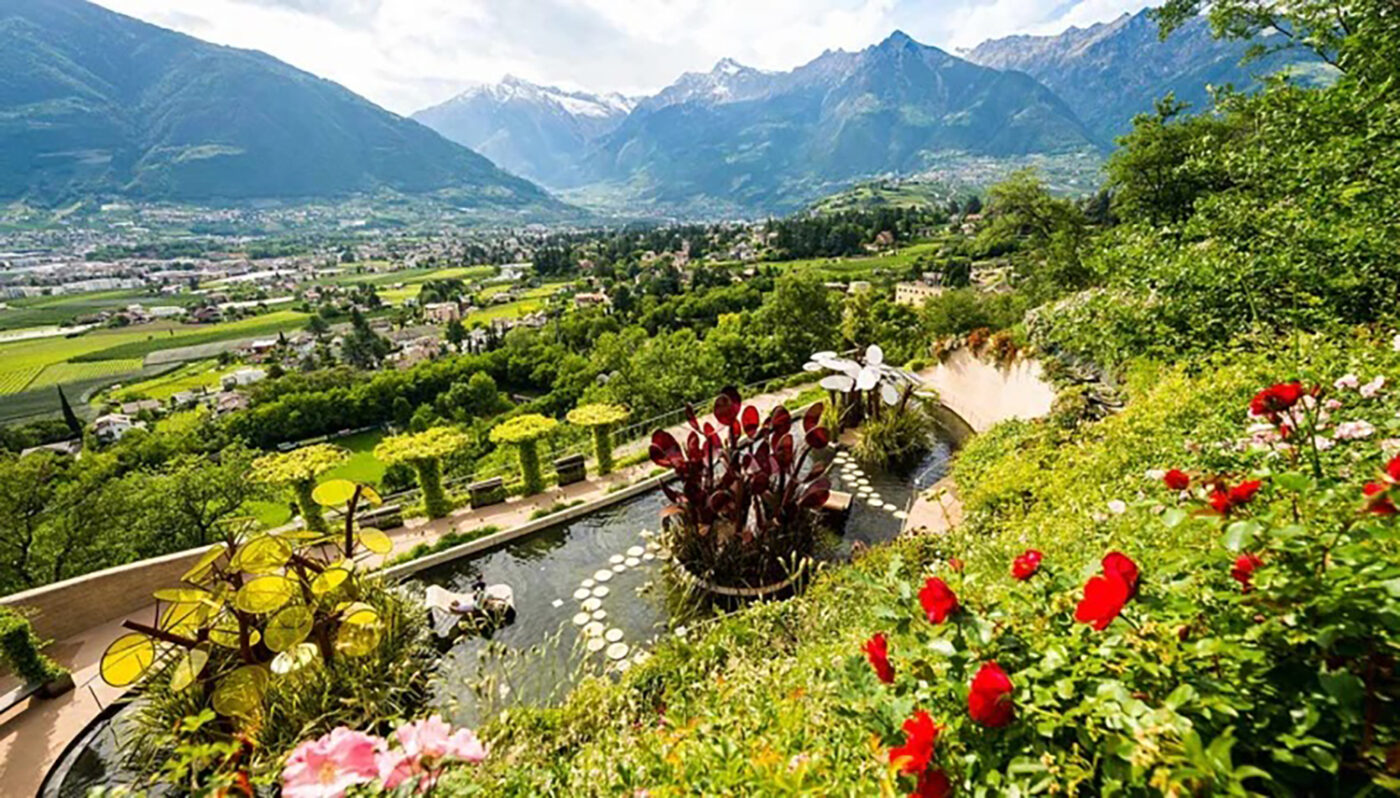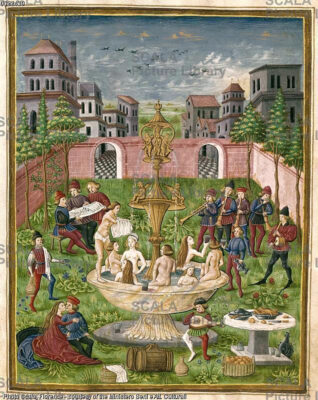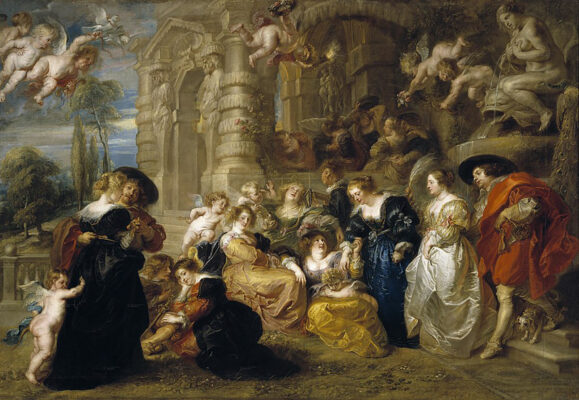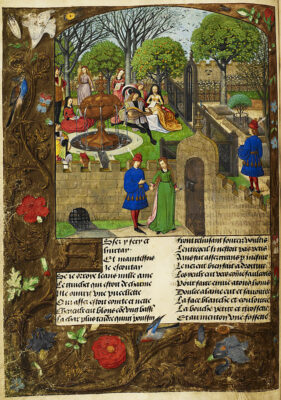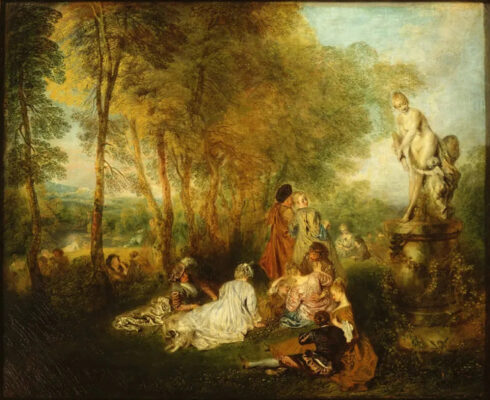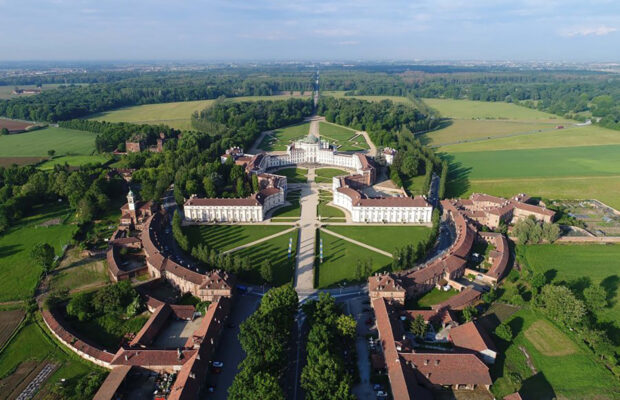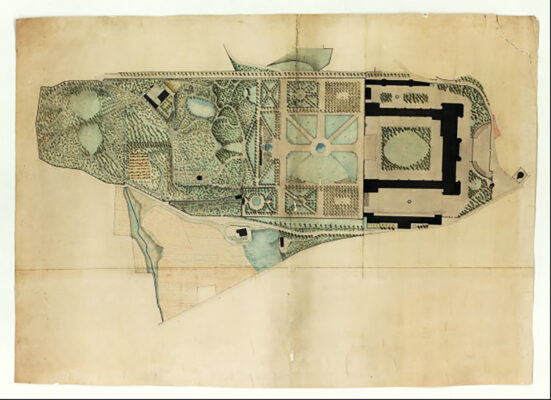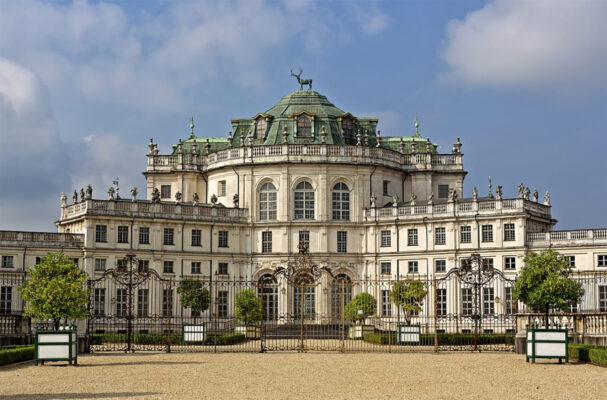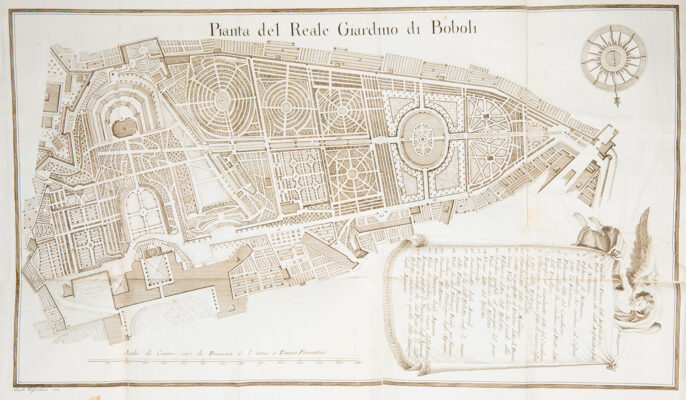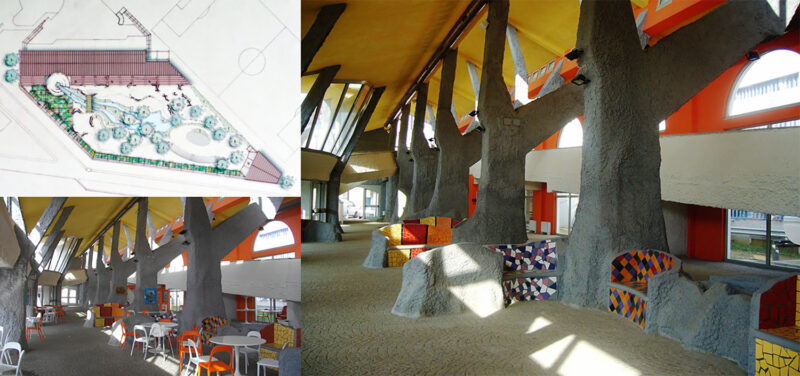The garden of love in history: from the gardens of Eden to the court gardens
Edmond Rostand wondered in the voice of Cyrano de Bergerac
What is a kiss then? An oath a little closer, a more precise promise, a confession that seeks confirmation, a rosy apostrophe between the words I love you, a secret blown into the mouth instead of the ear, a fragment of eternity that buzzes like the wings of a bee, a communion that smells of flower, a way to breathe the heart and exchange the flavor of the soul on the lips!
And what better place than a garden to share a kiss.
Before the 1200s, the gardens were only Hortus Conclusus: open spaces of monasteries and castles used for the cultivation of vegetables and fruit. Conclusus because these spaces were within high walls that were part of the important structures to which they belonged.
Already towards the middle of the 12th century the holy philosopher and scientist Albert the Great claims “There are some places that are not so much for need or for a rich harvest, as for pleasure.” And he calls them viridantia.
In the Middle Ages, therefore, the court garden or garden of love was born.
But what are the gardens of love of medieval courts like?
In these new gardens, monastic geometric cultivations are abandoned to focus on the color and scent of the flowers.
They are separated from the cultivation areas by fences and do not yet contain seats or furniture. You sit under the plants or on the grass to listen to music and stories of polite battles.
On walk in the shade of pergolas covered with vines and stop in pavilions. Small and harmless animals roam free or in the aviary. (trippando.it) …sex was not yet talked about.
Medieval gardens of love and the myth of Aphrodite
It seems, from unconfirmed sources that in medieval times the garden of love was called “The Garden of Aphrodite” – goddess of love.
But the myth of Aphrodite is also always understood as the principle of the cosmic form that invites us to look at the world with the eyes of the Soul and perhaps in this way we can give a soul to the world and return the world to the soul: “It is up to us to keep the world alight (…) a world without a soul will never be able to offer intimacy, will never return my gaze, will never be able to look at me with interest, with gratitude (…)” (testaferdinando.it) (Hillman)
I would add that love opens the soul and in nature the soul reverberates with emotion.
The gardens of love in literature: Tristan and Isolde
Also in the short story “Tristan and Isolde” by Gottfried von Strassburg, in a passage of their story, they find themselves talking in the garden secretly (they believe) from her husband – who then listens hidden on a pine tree:
[…] Loving Lord Tristan of Cornwall Ysotta the blonde, the wife of King Mark, they made a sign of love between them in this way: that when Sir Tristan wanted to talk to her, they went to a garden of King Mark, in which he had a fountain, and clouded the trickle she (the fountain) made, which passed through the palace where the said Ysotta was staying; and when she saw the turbid water, it was thought that Tristan was at the fountain. Now there was an ill-frightened gardener greedy for it, so that the two lovers could not believe him [in modo tale che i due amanti non potevano sospettare]. That gardener went to King Mark, and controlled [gli raccontò]everything as it was. […] (novellino – and Tristano and Isotta)
Oriental love gardens and the ideal of the gardens of Eden
But in 1200 the travels to the East had already begun and curiosities and plants were reported that have certainly taught how to design the aforementioned garden of pleasure and love.
In fact, we recall that, in the literary and collective imagination, paradise is located in the east and is often represented as a garden where among magnificent luxuriant and fragrant plants rest animals never seen before, waters gurgle in canals and fountains and chirp birds with melodious song and plumage of a thousand colors.
In fact, these idyllic gardens have actually existed in the East for hundreds of years and this is perhaps why our idea of paradise has this aspect.
In this regard, I recommend reading the article “The book of oriental dreams: Allegories and Wonders in the Oriental Gardens by Paola Maresca”.
Renaissance garden of love: The secret life of the court
We remain in the West. In the Renaissance period the garden became more complicated.
In front of and around the palace the garden is built in orderly geometric flower beds full of controlled color in forms that have the task of presenting the master of the house and his power.
Further on, often detached from the building, is the forest. This served not only the hunting – officially – but also the “secret life” of the court. A place in which it was not necessary to represent oneself to others, but to live the instincts in the most natural way.
In the woods, therefore, it was not difficult to find artificial caves equipped with seats inside to hide their presence from the sight of a meddling court. (skuola.net)
Now that I think about it, it would be really intriguing to make a list of the Italian Renaissance palaces and palaces and find out for each one where they broke … their lordships entertained themselves in moments of relaxation.
Examples and curiosities of love gardens in Italy
The gardens of the Reggia di Venaria in Turin they do not need the creation of a wooded area because the Royal Palace is surrounded by a natural wood now called Parco la Mandria which already had small medieval defense ruins inside which could represent a shelter from prying eyes.
The Boboli Gardens in Florence do not have a forest, but digging on the web I discovered that it was planned where the amphitheater was later built. The amphitheater was probably chosen for the natural depression created by the extraction of the stone useful for the construction of Palazzo Pitti. In short, compromises had to be made:
fake affairs (performed in the theater) instead of real ones.
Even the Stupinigi hunting lodge could rely on vast forest possessions all around the small building. This wonderful building that was built with the sole purpose of serving as a resting place between one hunt and another, today is a large compendium of places for the citizen to have fun.
[…] Eugenia Attendolo Bolognini Litta therefore moved to the Villa Litta in Vedano al Lambro, close to the royal palace of Monza, so that she could meet with her lover more confidentially. For his part, Umberto I of Savoy bought Villa Zendali, also in Vedano, as a hunting lodge. It was no coincidence that the garden of Villa Zendali was bordering that of Villa Litta […] (vanillamagazine.it)During the seventeenth century, Cardinal Scipione Borghese had four secret gardens designed on the sides of the Casino Nobile in Villa Borghese in Rome, where to grow citrus fruits and the rarest and most refined flowers of the time.
The private gardens restored at the end of the 90s of the last century have returned to flourish and today they offer themselves as the perfect places to tell the story and evolution of a secret garden and the botanical inspiration of the 1600s. (sovrintendenzaroma.it)
Speaking of Cardinals, I leave it to you to decide why he felt the need for 4 (not one) secret gardens …
In the collective imagination, these areas represent the secret and the element of chaos necessary for the life of each person. Then we didn’t have to know how they used it.
A different conception of the gardens of love: The garden of encounters
A reference to a meta-garden, different in origin and purpose, but which deserves attention is the “Garden of Encounters” of the Sollicciano prison.
This garden consists of a covered structure and a discovery that the inmates strongly wanted for meetings with their loved ones.
In the same way, in Italy and in the world, we are discovering how this environment is synonymous with Hope and helps inmates to see their own future outside of prison. Therefore, new “prison gardens” are being born, which we will gladly deal with later on.
In fact, it is always said that working in the garden is a Zen practice and allows for the healing of the body and spirit: It keeps you busy and delighted with the results.
Well. I hope this wandering through the woods and the anecdotes has inspired you.
Now on horseback! Work awaits us! Our new wonderful outdoor space is about to be born!
GOOD WORK and … if you have any questions please write to info@mondodelgiardino.com
image sources the painting “The lover and the lady idle outside the enclosed garden” from nrm.wikipedia.org; the painting “The Garden of Love” from culturaitalia.it; the aerial view of the Stupinigi building from terradellefate.it; the facade of the Stupinigi hunting lodge from histouring.com; the painting “Feast of love” by Jean Antoine Watteau from paghera.com; the painting “The Garden of Love” by Rubens from analisidellopera.it; the “Plan of the Royal Boboli Gardens” from picryl.com; the “Plan of the Garden of the Moncalieri Castle” from the Turin State Archives; the image of the “Garden of Encounters” from ristretti.it


